Polymer Chemistry | Term 3 Unit 3 | 7th Science - Questions Answers | 7th Science : Term 3 Unit 3 : Polymer Chemistry
Chapter: 7th Science : Term 3 Unit 3 : Polymer Chemistry
Questions Answers
EVALUATION
I. Choose the correct answers
1. The
first man-made fibre is _________
a. Nylon
b. Polyester
c. Rayon
d. Cotton
[Answer: (c) Rayon]
2. Which of the following is the
strongest?___________
a. Rayon
b. Nylon
c. Acrylic
d. Polyester
[Answer: (b) Nylon]
3. When you place a natural fibre
in a flame it____________
a. melts
b. burns
c. gets
nothing
d. explodes
[Answer: (b) burns]
4. A synthetic fibre which has
similar properties to wool is ____________
a. Nylon
b.
Polyester
c. Acrylic
d. PVC
[Answer: (c) Acrylic]
5. A good application of plastic
is the use of____________
a. Blood
bags
b. Plastic
cutlery
c. Plastic
straws
d. Plastic
carry bag
[Answer: (a) Blood bags]
6. ____________ is a
non-biodegradable material
a. Paper
b. A plastic
bottle
c. Cotton
cloth
d. Wool
[Answer: (b) A plastic bottle]
7. PET is the acronym for
____________
a. Polyester
b. Polyester
and terylene
c. Polyethylene
terephthalate
d. Polyetheneterylene
[Answer: (c) Polyethylene terephthalate]
II. Fill in The Blanks
1. Raincoat is an example of polyester fabric.
2. Resin codes are used to identify different types of plastics.
3. A polymer is a long chain made up of many repeated small units called monomers.
4.
A natural fibre is called
5.
A natural fibre obtained by boiling cocoons is called
III. True or False
1. A lot of plastic pollutes our
environment.
2. Refuse (avoid) is the best way to
manage plastic.
3. It is good to wear clothes made
of synthetic fibres while cooking.
Correct statement: It is good to wear clothes made of natural fibres while cooking.
4. Degradable plastics break down
into tiny pieces called microplastics.
5. Cotton is a natural polymer.
IV. Match the Following
A/ B
Nylon
-
Thermoplastic
PVC - Thermosetting plastic
Bakelite - Fibre
Teflon
-
Wood pulp
Rayon
-
Non-stick cookwares
Answer:
A B
1. Nylon : Fibre
2. PVC : Thermoplastic
3. Bakelite : Thermosetting plastic
4. Teflon : Non-stick cookwares
5. Rayon : Wood pulp
V. Arrange in Correct Sequence
1. Mix water, starch, vinegar and
glycerin in a cooking pot.
2. Let the article cool for 24 hours
before we use it.
3. Shape material to form a cup or
bowl.
4. Continuously mix on medium heat
until the liquid turns clear
5. When the liquid begins to bubble
it is ready to be taken off the stove.
6. Spread the gel onto aluminium
foil and cool.
Answer:
1. Mix water, starch, vinegar and glycerin in a cooking pot.
4. Continuously mix on medium heat until the liquid turns clear.
5. When the liquid begins to bubble it is ready to be taken off
the stove.
6. Spread the gel onto aluminium foil and cool.
3. Shape material to form a cup or bowl.
2. Let the article cool for 24 hours before we use it.
VI. Analogy
1. Cotton: natural : Polyester: Synthetic
2. PLA spoon : compostable : Plastic
spoon :
3. Nylon :melts on heating :
Silk:
VII. Assertion and Reason
1. A: Vegetable peels buried in the
soil disappear within two weeks.
R: Vegetable peels are compostable.
[Answer: (a) Both A and R are true and R is the
correct explanation of A]
2. A: It takes a very long time for
nylon clothes to breakdown into microfibers but cotton clothes need only six
months to decompose.
R: Nylon made out of petrochemicals is non-biodegradable and cotton cloth is biodegradable.
[Answer: (a) Both A and R are true and R is the
correct explanation of A]
3. A: It is good to avoid plastics.
R: Plastics end up polluting the
environment.
[Answer: (a) Both A and R are true and R is the
correct explanation of A]
VIII. Crossword
Across
1.
Fibre that is used as synthetic wool.
2.
A plastic used for making water bottles.
3.
A long chain made of small repeatingmonomers.
4.
Another name for this semi-synthetic fibre is artificial silk.
Down
5.
A type of fibre that is naturally obtained from a cocoon.
6.
A synthetic fibre classified as polyester.
7.
A polymer used for making rope.
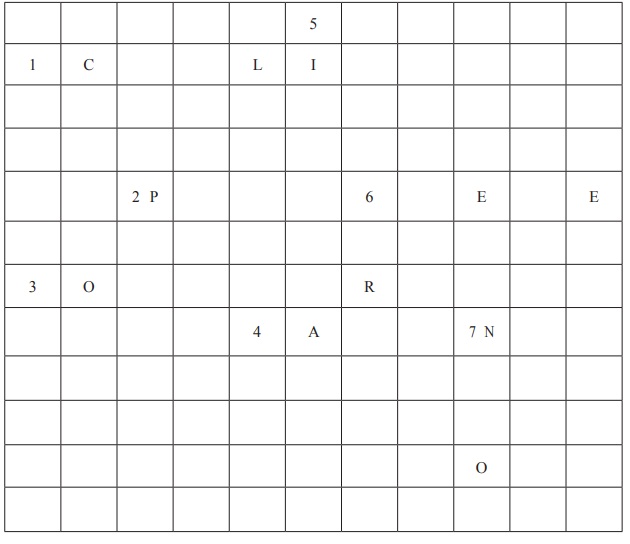
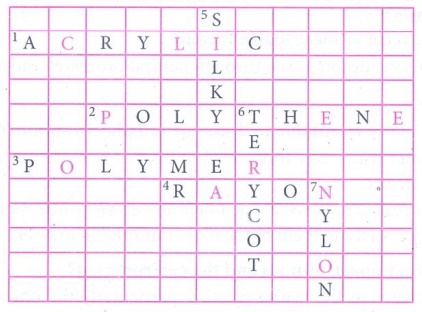
IX. Very Short Answer
1. What
is the chemical name of the polymers that make up cotton?
Answer: Cellulose.
2.
What gives plastic different qualities and characteristics?
Answer: Different
chemicals (additives) are added to plastic to give them various qualities and
characteristics.
3.
It is not advisable to burn plastic and synthetic fabrics. Why?
Answer: Burning
of plastics and synthetic fabrics is not a good solution, as we end up wasting
non-renewable resources and produce super toxic chemicals that are difficult to
store or dispose safely.
4.
A bucket made of plastic does not rust like a bucket made of iron. Why?
Answer:
(i) The reason is due to their chemical composition.
(ii) The bucket is made of plastic which does not react with the
oxygen and humidity present in air.
(iii) While the iron reacts with the oxygen, air corrodes
to form rust.
5.
Why is it better to avoid the use of plastic products?
Answer:
(i) Plastics do not decompose by natural processes and action of
bacteria and are therefore not biodegradable.
(ii) A lot of the plastic produced globally is designed to be used
only once and thrown away, creating a large amount of plastic waste.
(iii) Plastic waste ends up being recycled, incinerated, landfilled,
dumped or ends up littering our environment.
(iv) So, it is better to avoid the use of plastic products.
6.
Give two examples of thermosetting plastics.
Answer: Bakelite,
Melamine.
7.
What is the 5 R principle?
Answer: Plastic
disposal is the 5 R principle, Refuse, Reduce, Reuse, Recycle and Recover is
called as 5 R principle.
X. Short Answer
1. What does the term biodegradable
mean?
Answer: A
material that gets decomposed through natural processes and action by bacteria
is called biodegradable.
2. What kind of fabric is
suitable to dress-up and play in the summer?
Answer:
(i) In summer it is better to wear clothing that is made out of
cotton materials rather than synthetic.
(ii) This is because most synthetic fibres absorb very little
moisture and do not allow air circulation making them hot and uncomfortable to
wear.
3. How do plastics impact animals
and the environment?
Answer:
(i) The increase in the use of plastics, particularly the one-time
use and throw away plasticshas serious impacts on the environment, animals and
our health.
(ii) We have seen garbage dumps with different plastics. One big
problem with plastics is that they do not decompose or biodegrade.
(iii) This leads to large amounts of waste that will not disappear
and end up accumulating and polluting the environment.
(iv) Many animals confuse plastic for food and eat it by accident.
When leftover food is thrown away it is often packed in plastic. Animals smell
the leftover food and eat the plastic by accident.
XI. Long Answer
1. List the advantages and
disadvantages of synthetic fibres.
Answer:
Advantages and Disadvantages of synthetic fibres.
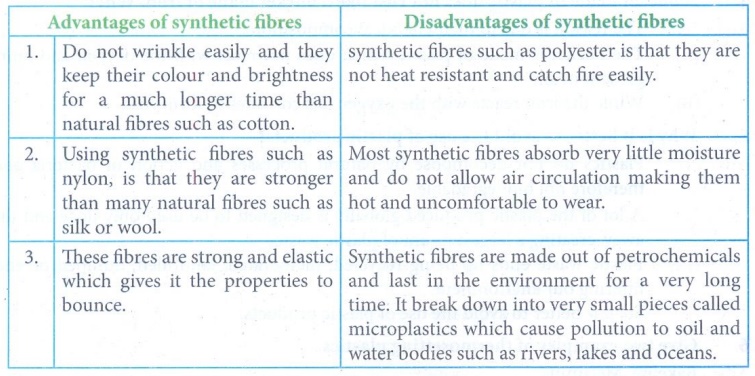
Advantages of
synthetic fibres
1. Do not wrinkle easily and they keep their colour and
brightness for a much longer time than natural fibres such as cotton.
2. Using synthetic fibres such as nylon, is that they are
stronger than many natural fibres such as silk or wool.
3. These fibres are strong and elastic which gives it the
properties to bounce.
Disadvantages of
synthetic fibres
1. synthetic fibres such as polyester is that they are not heat
resistant and catch fire easily.
2. Most synthetic fibres absorb very little moisture and do not
allow air circulation making them hot and uncomfortable to wear.
3. Synthetic fibres are made out of petrochemicals and last in
the environment for a very long time. It break down into very small pieces
called microplastics which cause pollution to soil and water bodies such as
rivers, lakes and oceans.
2.
Suggest safe methods of disposing plastics.
Answer: Refuse
(Avoid):
(i) The best thing to do is to avoid using plastic products.
(ii) One-time use throw away plastics can often be avoided.
Reduce : Reducing the amount of plastic we use is important.
Reuse : If possible products made of plastics can be used again and
again.
Recycle:
(i) It is better to recycle plastic waste.
(ii) Separating plastic waste (based on the resin code) and making
sure it gets recycled is good as it turns waste materials into something new.
(iii) Then it will not be thrown away in landfills, open dumps or
ending up as litter in the environment.
Recover (Compost and
Incinerate): Solid waste can be converted into
resources such as electricity and compost through thermal and biological means.
XII. HOTS
1. The Tamil Nadu Government has
banned the use of one-time use throwaway plastics. Why do you think this is
important?
Answer: It is important to reduce the negative consequences of plastics
on the environment.
2. A plastic bag dumped in the
soil stays without breaking down for 500 years. If a new generation starts in
every 30 years, how many generations would it take to see the plastic bag
finally broken down?
Answer: It
would take 16 to 17 generations to see the plastic bag finally broken down.
XIII.
i) Fill in the blanks
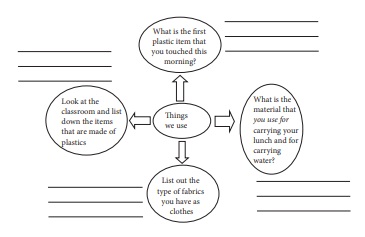
Answer:
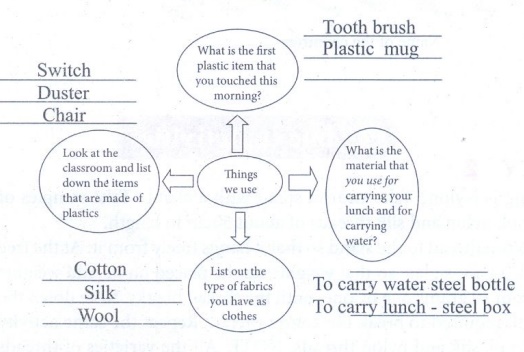
ii. Look at the following picture
and explain what is happening.
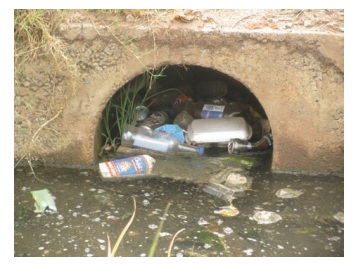
Answer: A lot of one-time use plastic such as polythene bags and food
packaging that are thrown away are responsible for littering the environment
and clogging drains. Standing water breeds mosquitoes that can spread diseases
such as malaria dengue and chickungunya and also lead to flooding.
iii. Read the following information
and convert them into a graph to compare the countries and the amount of
plastic they use.
China contributes the highest share
- that is around 28%, of the total plastic used globally. Indonesia uses 10%,
both the Philippines and Vietnam use 6% each; Thailand uses 3.2%, Egypt 3%,
Nigeria 2.7% and South Africa 2%.
Answer:
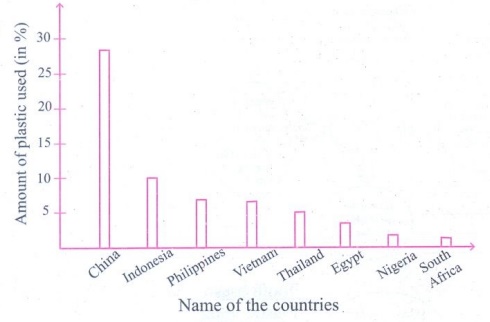
Related Topics